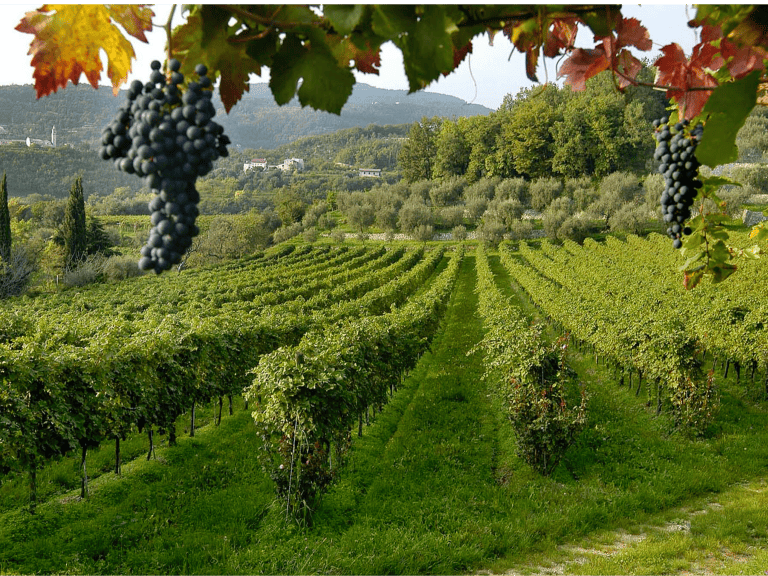This advertising content was produced in collaboration with our partner Santa Margherita USA.
Italy—sometimes called one big vineyard—is a mosaic of microclimates, from mountainous to coastal, Alpine to sun-baked. They vary so much that it makes little sense to speak of “Italian wine” in and of itself.
“Respecting the land, the product that comes from it, and respecting the people and tradition from these lands—these guiding principles have been with us a long time,” says Vittorio Marzotto, business development director and a fourth-generation member of the Gruppo Santa Margherita family wine business, explaining their portfolio-building strategy that includes estates from across the country.
If wildly different terroirs naturally yield wildly different wines, that poses a challenge for any Italian portfolio comprising wines from multiple regions: how to craft distinct estates that stand out in a market so singularly defined by regionality. For Gruppo Santa Margherita, a firm famously driven by white wine, more than two decades passed between adding primarily-red wine brands—Lamole di Lamole in Tuscany, founded in 1993, and Cantina Mesa in Sardinia, acquired in 2017.

Don’t miss the latest drinks industry news and insights. Sign up for our award-winning newsletters and get insider intel, resources, and trends delivered to your inbox every week.
“In Lamole di Lamole, we started from tradition and a great terroir, but we kept experimenting to get the best expression. We were able to revamp and upgrade the estate and the wine,” says Marzotto.
Jumping to 2017, when the Marzottos pinpointed Cantina Mesa in Sardinia—a winery founded just 13 years earlier by an advertising executive who returned to his native island—tradition was not a factor. But targeting an exceptional terroir with indigenous grapes was.
“The strategy there [at Mesa] was to get a new region on the rise in Italy, and help define them in the international arena,” says Marzotto. “To start with a unique terroir where we can experiment and create a solid story and capture the same values from the beginning, with respect for the land and people and the highest expression of local varieties.”
Respect for terroir, he explains, is the starting point, which in turn guides site-specific innovation in these two estates.

Santa Margherita
As one of Italy’s largest family-owned wine producers, Santa Margherita has developed a reputation for excellence across a diverse range of prominent wine regions.
High Stakes in Tuscany
Altitude is the most prominent factor impacting Lamole di Lamole’s terroir. The estate’s five distinct vineyards stand at one of Tuscany’s highest points, practically in the dead center of Chianti Classico, between 1,150 and 2,000 feet above sea level. The estate’s five south- and west-facing vineyards enjoy low summer rainfall, pronounced winds, excellent exposure to sunlight, and wide diurnal shifts in temperature.
Those swings are known to preserve acidity, but Sangiovese needs warmth to achieve full ripeness. When the Marzotto family took over the estate in 1993, they restored the vineyards’ network of stone terraces, which absorb and reflect the sun during the day (enhancing photosynthesis) and release the heat at night.
Reinforcing the terraced vineyards set the stage for other ways that Lamole di Lamole adapted its rugged site. (The name may derive from the phrase la mole—a mass or boulder—in reference to the rock outcrop on which the castle of Lamole is built.) In addition to gaining organic certification for all of Lamole di Lamole’s vineyards, in an effort to match Sangiovese clones to the high elevation, they developed an experimental vineyard, starting with 30 clones to find the best fit. Today, a handful of clones are matched to the site including the historical clone called Sangiovese di Lamole. In the permeable Tuscan macigno, a mix of schist-like Albarese and Galestro (sandstone marl) that is rich in nutrients and minerals but also good-draining, these clones produce loosely packed bunches with smaller berries and a higher skin-to-juice ratio, adding richness and length.
Before grapes even enter the winery, they go through an optical sorter that gauges both sugar levels and skin density. Once inside, the Sangiovese, as well as smaller lots of other varieties, are guided by Andrea Daldin, winemaker at Lamole di Lamole for over 25 years. Lots are kept separate for a full year: Sangiovese ages in large (50-70 hl), old oak casks; Cabernet Sauvignon and Merlot rest in second-and third-use barriques.
Sarah Clarke, former beverage director with the Mozza Restaurant Group in Los Angeles, explains that the separation is key, as it sets the stage for blending. “They are way above sea level, which is really great for lean, slightly higher-acid Sangiovese, but they are very smart to add Cabernet and Merlot [20 percent] to level off the acidity,” says Clarke.
Strategic treatment keys the other Lamole di Lamole bottlings as well. The Chianti Classico Riserva gets extended maceration and 5 percent of the traditional Tuscan variety, Canaiolo. The Gran Selezione, from a single vineyard, is aged in varied barrels and gets around 5 percent old-vine Cabernet Sauvignon interplanted in the same vineyard. Clarke sees the Chianti Classico pairing classically with bistecca di Fiorentina; and for the Gran Selezione, a porcini-crusted seared ribeye.
Singularly Sardinian
Centered in the Mediterranean Sea, “Sardinia is closer to Tunisia than it is to mainland Italy,” says Marzotto. “Sardinia is another world, in history, traditions, food.” But as at Lamole di Lamole, decision-making at Cantina Mesa takes terroir as a starting point.
The emphasis on traditional Sardinian grapes was in place, as was the gravity-flow design setting the stage for minimalist intervention in the striking white hillside winery. Revamping was not called for so much at Mesa; Marzotto refers to it as “Winery 2.0.” Fermentations are done by variety, with old-vine fruit separated. Both the Cannonau and Carignano are destemmed, lightly crushed, fermented at warm temperatures, and kept in stainless steel to preserve the ripe fruit character and savory nuances.

Cannonau (aka Grenache) thrives in clay and gravel; sandy soils favor Carignano (Carignan). While Meas’s 170-plus acres of vineyards are not certified organic, the warm, dry, well-ventilated climate (they also share the mistral winds with the Rhône Valley) allows for sustainable practices and no chemical usage. Vines are largely trained to spurred cordon, or grown bush style, depending on specific conditions (“We have six different soil types in the vineyards,” notes Marzotto).
Mesa’s red wines have built-in appeal for American fans, notes John Poggemeyer, director of wine operations at Heinen’s, a chain of gourmet markets in Ohio and Illinois. “We are very lucky that our customers have a lot of trust in us, so we often make associations when recommending wines,” says Poggemeyer. “The Mesa reds are 100 percent in the picture for people who like Rhône reds, but they are more of a discovery.”
Sardinia, of course, is not the Rhône Valley and vintners take a proudly independent view of their wines. Reinforcing that sentiment, Cantina Mesa wines sport proprietary names—Buio (boo-yo) and Buio Buio for the regular and old-vine Carignano; Primo Scuro for the Cannonau—and their labels feature traditional Sardinian tapestries.
Like Clarke in Los Angeles, Poggemeyer at Heinen’s considers both Cantina Mesa and Lamole di Lamole to be not just true to type, but also exemplary. “We know our sources,” he says, “both are superior representations of terroir.” He adds that Cantina Mesa wines are in line to be featured in a chain-wide program called “Off the Beaten Path.”
That connection, both to their respective sites and the concerted efforts to transcend regional typicality, is what gives the Sardinian Cantina Mesa and Tuscany’s Lamole di Lamole a copacetic spot in the Santa Margherita portfolio. The estates express their uniqueness, but share their proactive approach to authentic Italian terroir.

Dispatch
Sign up for our award-winning newsletter
Don’t miss the latest drinks industry news and insights—delivered to your inbox every week.










